Top Qs
Timeline
Chat
Perspective
Muk (food)
Jelly-like starch based food From Wikipedia, the free encyclopedia
Remove ads
Muk (Korean: 묵) is a Korean food made from grains, beans, or nut starch such as buckwheat, sesame, and acorns and has a jelly-like consistency. Muk has little flavor on its own, so muk dishes are seasoned with soy sauce, sesame oil, chopped scallions, crumbled gim, and chili pepper powder, and mixed with various vegetables.[1]
Remove ads
Types
There are several types of muk:[2]
- Dotori-muk (도토리묵), made from acorn starch
- Memil-muk (메밀묵), made from buckwheat starch
- Nokdu-muk (녹두묵) (also called cheongpo-muk; 청포묵), made from mung bean starch
- Hwangpo-muk (황포묵) (also called norang-muk; 노랑묵), made from mung bean starch, and colored yellow with gardenia seed pods[3]
- Kkae-muk (깨묵), made from starch mixed with sesame seeds
- Olbanggae-muk (올방개묵), made from water chestnuts
Remove ads
Muk dishes

- Muk-muchim (묵무침), muk dish seasoned with ganjang (Korean soy sauce), sesame or perilla oil, finely chopped green onions, sesame seeds, and red chili pepper powder. It can be mixed with sliced or shredded cucumber, and leaf vegetables, such as chopped lettuce, cabbage or napa cabbage. The dish can also be served with only crumbled gim (Korean nori) added as a garnish.[4]
- Tangpyeong-chae (탕평채), made with thinly sliced nokdumuk, beef, vegetables, and seaweed.[5]
- Muk-bokkeum (묵볶음), a stir-fried muk dish.[1]
- Muk-jangajji (묵장아찌), marinated muk in soy sauce[6]
- Muk-jeonyueo (묵전유어) or mukjeon (묵전), made by pan-frying sliced muk that has been coated with mung bean starch.[7]
- Muk-sabal (묵사발) or also called mukbap (묵밥), cold soup made with muk and sliced vegetables.[8]
Remove ads
See also
References
External links
Wikiwand - on
Seamless Wikipedia browsing. On steroids.
Remove ads

